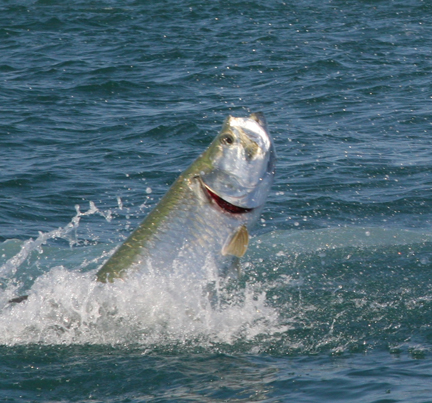
Tarpon genetics study ongoing
By Stan Kirkland, FWC
This week I had the good fortune to attend a half-day workshop on tarpon biology and management at the Apalachicola National Estuarine Research Reserve in Eastpoint. There were several speakers but I particularly wanted to hear the comments of Dr. Kathryn Guindon, a research scientist with the Florida Fish and Wildlife Conservation Commission’s (FWC) Fish and Wildlife Research Institute in St. Petersburg.
There were probably 30 people in attendance, including tarpon fishing guides from around the Big Bend, several school teachers wanting to take info back to their science or outdoor education classes and a handful of FWC staff. It was the second workshop in two days in the Franklin County area.
I first met Dr. Guindon about 7-8 years ago when she was doing pompano research here in Panhandle waters. She’s a top-notch researcher and well respected in the fisheries science profession.
She talked about tarpon biology, including some of what is known about tarpon spawning in the Gulf of Mexico and their spring migration patterns. She shared that tarpon populations over winter in the Florida Keys. Researchers also say a population winters off southern Mexico.
As waters warm in the spring, the fish move up the coast of Florida toward the Panhandle, going as far as Alabama and Mississippi waters. At the same time tarpon move up the Atlantic coast, reaching the chilly waters of some of the more northern states. In Mexican waters tarpon move north, some going as far as the waters off Texas and Louisiana.
During the fall this daisy-wheel movement of hundreds of thousands of fish reverses itself and the fish return to warmer waters. These fish have likely followed this pattern of movement for thousands of years.
The majority of Dr. Guindon’s comments, however, centered on encouraging anglers and guides to participate in the on-going Tarpon Genetic Recapture Study. Both FWC and Mote Marine Laboratory in southwest Florida are collaborating in the long-term study.
Beginning in 2005, tarpon anglers were asked to participate in the study by collecting skin cells from around the mouth of tarpon they caught. FWC and Mote give the small capture kits to any angler willing to participate in the study.
Dr. Guindon explained that each tarpon has unique DNA and the cells are analyzed at the FWRI facility. DNA information is retained on every fish sampled and scientists know if the fish are original captures, or recaptured fish, where they moved and how much they’ve grown. The information yields insights movements of juvenile and adult fish, seasonal movements and habitat they prefer.
Thus far, about 13,000 samples have been returned and analyzed. Most of the fish sampled were from Florida waters. While there are many anglers fishing for tarpon in Panhandle waters, she said only 72 samples have been returned from local waters. Guindon said she is hoping as word of the study spreads that more anglers will become involved. She said one thing they’ve learned is that of every 100 tarpon caught by anglers, one of those fish is a recapture (caught before).
She said any anglers willing to assist in the study can obtain the easy-to-use DNA sampling kits by e-mailing TarponGenetics@MyFWC.com, or calling 800-367-4461. Guindon said those who recapture a tarpon are provided information about the tarpon, including where the fish was first caught.
Sk/
